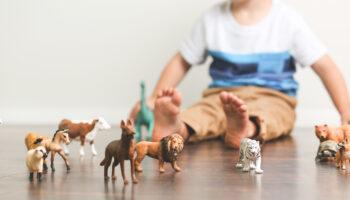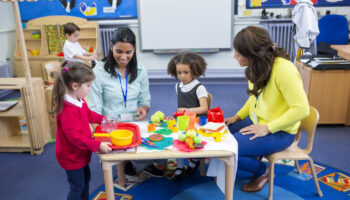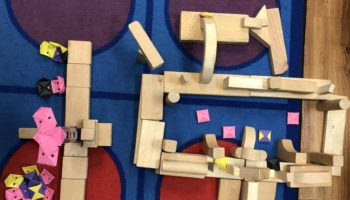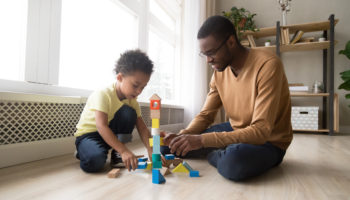Angel Avery-Wright
How often do you hear yourself saying, “Stop throwing the blocks” or ‘That’s not how we play with blocks” or “Throwing blocks at your friends will hurt them?” Is this something you say once in a while, or do you find yourself saying it frequently? Do you find yourself sitting in the block area to supervise most of the time? Do you “close” the block center due to unsafe behaviors?
I am going to discuss some ways to help children engage in more appropriate block play.
Space
Let’s start with the environment. Is there enough space? Blocks were meant for building: towers, castles, bridges, roads, zoos, houses, farms, office buildings, etc. But you can’t build anything if there isn’t enough space. If there are three children in your block area and each child is making a different building, will they be bumping into each other or each other’s work? Think about your own workspace. If your elbows are bumping your files or you can’t see over the bins you are storing your extra work in, you might not have enough space to do your work comfortably. You probably won’t throw the bin at your co-worker, but you might get frustrated. Does your block play center have enough space?
Accessories
So now you’ve built the best creation in the world. How do you play with that castle? You need a princess and a dragon. How do you play with the barn? You need a horse and a cow. How do you use the bridge you built? With cars and trucks that fit the size of the bridge. Accessories are important and best practices suggest size appropriate people, animals, and vehicles. If you have a bridge that is 3 inches wide and a truck that is 6 inches wide, it doesn’t leave much room for playing. Looking at your block center, what accessories do you have, and do they match the blocks you have?
Pictures
Sometimes the block walls are blank. Sometimes there are photos of famous buildings such as the Taj Mahal, Buckingham Palace, and the Washington Monument. When children see these structures, can they make them from blocks? Well, using their imaginations they can. Some children may find this defeating. Include them. They show culture and differences. But also include some photos of what the children have built: Joey’s bridge, Tamara’s castle, and Jesse’s Zoo. This will remind them of what they built before, and other children may try to imitate them. A third option is to include drawings of actual block shape structures that you have put together. Simple structures with 5-6 blocks in them and label them what they are. A house may have four rectangular blocks with a triangular block on top. What pictures do you have in your block area?
Imagination
How many times have you heard, or said, “Use your imagination?” Like any other skill, this has to be taught. Whether it’s a baby saying it’s first word or 9th grade algebra, someone was the teacher and usually by modeling or demonstrating, taught the child how to do something. Do your children need to see someone play in the block area before they can? Playing with them and showing them how to play can be an important step in teaching them how to create a play environment for themselves.
Still throwing the blocks. Now it’s time to look at who is in the block area. Is it the same child or pairing of children that tend to throw the blocks? If it is one child, consider anything the child might be going through. Are his parents separating, did grandma move in, did a sibling go away to school? Is there an ill family member who requires a lot of time and attention?
You notice that whenever Angel and Jack are in the block area together, blocks get thrown. Observe to find out if the throwing is preceded by any specific actions. Did Jack take Angel’s blocks? Did Angel knock down Jack’s tower? When the blocks are thrown, is it to intentionally hurt someone else, is it out of anger and frustration or do the children need some gross motor time where they can throw something (a ball). These are all things to reflect on to reach the social emotional learning aspect of playing with peers. Instead of closing the block area, restrict it for a little while, separating those that have a hard time playing safely with one another.
The last idea is to look at the developmental abilities of the child. Does the child have developmental delays that could hinder him learning to play with the blocks appropriately at this time? Does he need constant supervision? Does he need soft blocks for now?
Checking the environment, materials and children’s needs will help identify any areas that could be improved upon to create a playful but safe block area.




